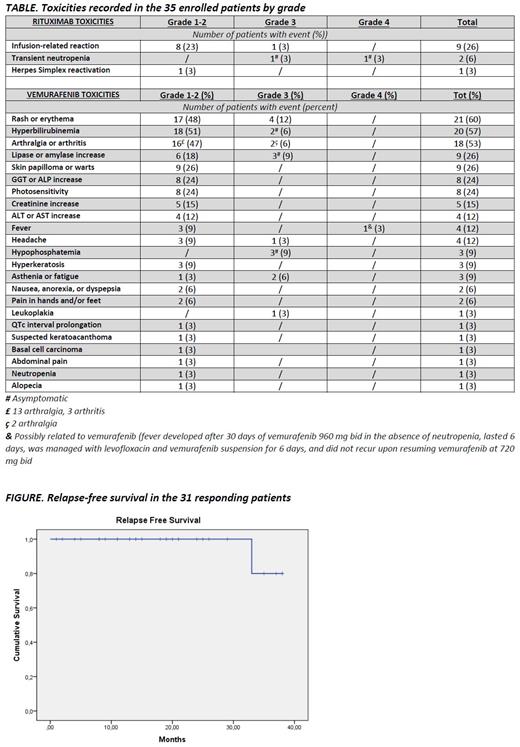BACKGROUND
Hairy cell leukemia (HCL) is a BRAFV600E-mutated indolent B-cell neoplasm (Tiacci et al., NEJM 2011) often relapsing after chemotherapy with purine analogs. BRAF inhibition is very active in relapsed/refractory (R/R) HCL, but produces mostly partial remissions (PR) and never clears minimal residual disease (MRD) (Tiacci, Park, et al., NEJM 2015). In a recent phase-2 single-center study on 30 R/R patients (pts) with a median of 3 prior therapies, a short chemotherapy-free regimen of the BRAF inhibitor vemurafenib (V) + rituximab (R; Mabthera) led to 87% complete remissions (CR), 60% MRD-negativity and 85% relapse-free survival (RFS) at a median follow-up of 34 months, with a favorable toxicity profile (Tiacci et al., NEJM 2021).
METHODS
A multi-center retrospective study was conducted to validate in a real-world setting the off-label use of V+R in R/R HCL needing therapy due to cytopenia(s).
RESULTS
From 6/2019 to 12/2021, 35 pts (median age 56 years, range 42-80) were treated at 14 Italian centers with VR (V: 960 mg bid for 8 weeks; R: 375 mg/m2 every 2 weeks for 8 doses); biosimilar R was used in 89% of pts. Prior therapies (median 2; range 0-11) included chemotherapy with cladribine or pentostatin (94% of pts), interferon-alpha (29%), rituximab (31%), splenectomy (6%), BRAF inhibitor monotherapy (6%) and zanubrutinib (3%).
Median blood counts across the 35 pts were: platelets 69000/mmc, neutrophils 860/mmc and hemoglobin 11.6 g/dl (with 20% of pts, i.e. 7/35, requiring transfusions). Eleven pts (31%) had active (n=3) or latent (n=8) infections, including: ongoing systemic atypical mycobacteriosis (n=1); ongoing miliary tuberculosis (n=1; a 80-year old pt who was the only one receiving V+R as first-line therapy); ongoing large cerebral abscess (n=1); HIV infection controlled by anti-viral therapy (n=1); and latent tuberculosis (n=1) or HBV (n=6) infections requiring anti-microbial prophylaxis.
Toxicity was as expected, mostly of grade 1-2 and always reversible (Table), allowing high relative dose intensities (RDI) for both drugs (V, median 97%; interquartile range/IQR 73-100%; R, 100% in 85% of pts). Similarly, among the 33/35 (94%) pts who received V for a substantial duration (≥35 days), and were thus evaluable for dose density, 20 pts (61%) completed V without ever suspending the drug, including 14/33 pts (42%) without any dose reduction. Vemurafenib toxicities were mainly represented by cutaneous rash, asymptomatic liver and pancreatic laboratory abnormalities, arthralgia, warts and photosensitivity.
Three pts (9%) were not evaluable for response as they died prematurely due to atypical mycobacteriosis, complications of neurosurgery for cerebral abscess and sudden death unrelated to study drugs.
Recovery of platelets (≥100000/mmc), neutrophils (≥1500/mmc) and hemoglobin (≥ 11 g/dl) occurred quickly, after a median of 2, 4 and 7 weeks after starting treatment, respectively.
A CR was observed in 30/32 evaluable cases (94%; or 86%, 30/35 pts, by intention to treat/ITT). CR was obtained in all evaluable cases refractory to chemotherapy (n=8) or rituximab (n=3), or previously splenectomized (n=2) or unable to reach CR with a prior BRAF inhibitor (n=2). The only 2 evaluable pts not achieving a CR (1 PR; 1 short-lived resolution of cytopenias) received V at only 16%/50% RDI and R at only 13%/34% RDI due to drug toxicities.
Analysis of MRD by allele-specific PCR for BRAF-V600E in the bone marrow aspirate was performed in 30 pts and showed MRD clearance (<0.05% mutant alleles) at a high rate: 79% (22/28 CR pts; or 65%, 22/35 pts, by ITT), which raised to 82% (66% by ITT) when including 1 additional CR case untested by PCR which had negative bone marrow flow cytometry.
At a median follow-up of 21 months after the end of treatment, RFS was high among the 31 responding pts, with just 1 relapse (3%) in the only case obtaining a PR post-therapy (Figure).
CONCLUSIONS
This study validates in a real-life context the high efficacy and tolerability of the V+R chemo-free regimen delivered to R/R HCL pts, including the cost-saving use of biosimilar rituximab.
OffLabel Disclosure:
Tiacci:Kite-Gilead: Consultancy; Deciphera: Consultancy; Innate Pharma: Consultancy. Visentin:Abbvie: Consultancy, Membership on an entity's Board of Directors or advisory committees; AstraZeneca: Membership on an entity's Board of Directors or advisory committees, Research Funding; BeiGene: Membership on an entity's Board of Directors or advisory committees, Research Funding; Janssen: Membership on an entity's Board of Directors or advisory committees; Takeda: Speakers Bureau; CSL behring: Membership on an entity's Board of Directors or advisory committees. Ferrero:Servier: Membership on an entity's Board of Directors or advisory committees, Speakers Bureau; Clinigen: Membership on an entity's Board of Directors or advisory committees; Incyte: Membership on an entity's Board of Directors or advisory committees; Morphosys: Research Funding; Beigene: Research Funding; Sandoz: Consultancy; Abbvie: Consultancy; Janssen: Consultancy, Membership on an entity's Board of Directors or advisory committees, Research Funding, Speakers Bureau; EUSA Pharma: Consultancy, Membership on an entity's Board of Directors or advisory committees, Speakers Bureau; Gentili: Speakers Bureau; Italfarmaco: Membership on an entity's Board of Directors or advisory committees. Sanna:Janssen: Consultancy, Speakers Bureau; Abbvie: Consultancy, Speakers Bureau; Astrazeneca: Consultancy, Speakers Bureau. Visco:AbbVie, BMS, Incyte, Roche, Pfizer, Janssen, Lilly: Membership on an entity's Board of Directors or advisory committees; AbbVie, Lilly, BMS, Astra Zeneca, Servier, Incyte, Roche, Pfizer, Novartis, Gentili, Janssen, Kite-Gilead, Beigene: Honoraria, Speakers Bureau. Pulsoni:SANDOZ: Honoraria, Speakers Bureau; TAKED: Consultancy, Honoraria, Speakers Bureau; GILEAD: Consultancy, Honoraria, Speakers Bureau; Bristol Myers Squibb: Honoraria, Speakers Bureau; MSD: Honoraria, Speakers Bureau; Roche: Consultancy, Honoraria, Speakers Bureau; JANSSEN: Honoraria.
Vemurafenib has been used off-label. Over 90% of patients with hairy cell leukemia are found to be positive for the BRAF V600E mutation, and the use of BRAF inhibitors like vemurafenib in hairy cell leukemia is now established, even though there is no official indication for these drugs


This feature is available to Subscribers Only
Sign In or Create an Account Close Modal